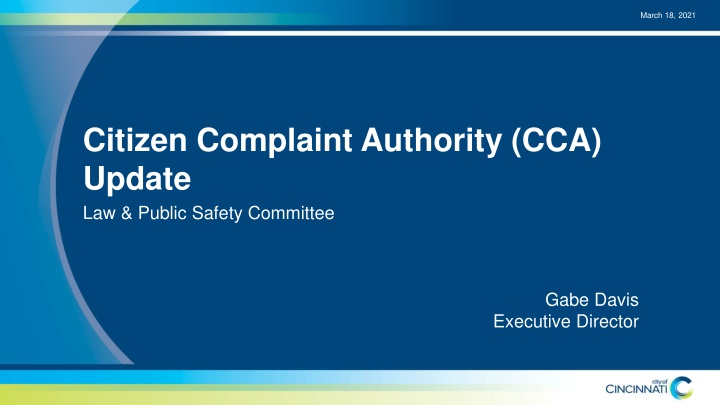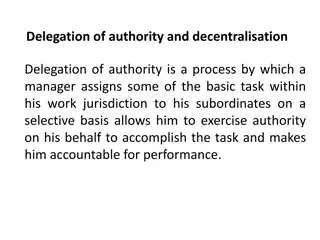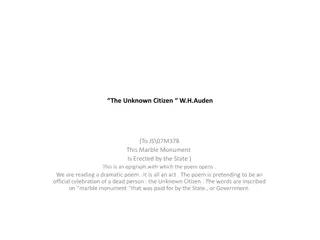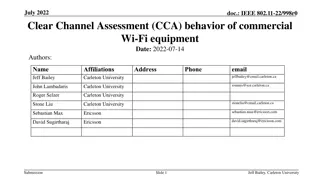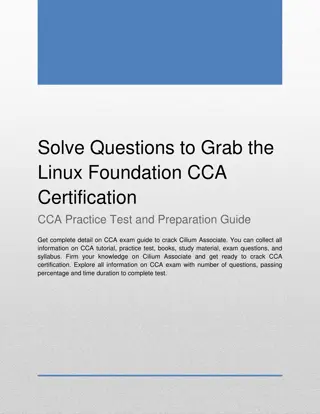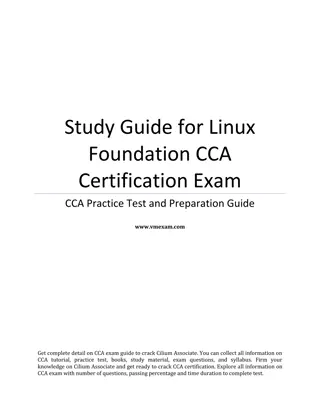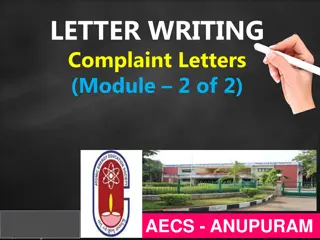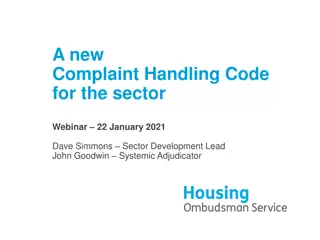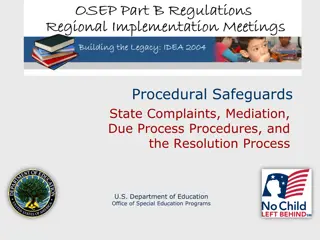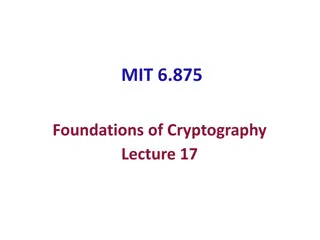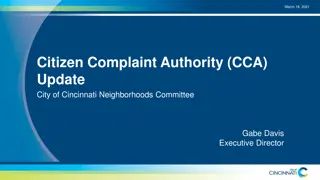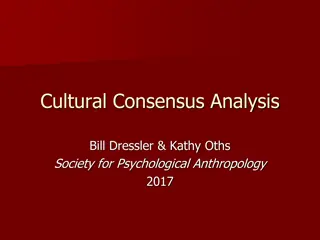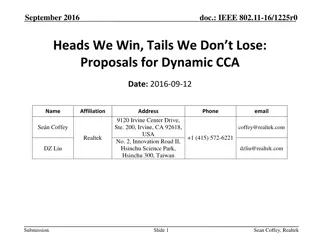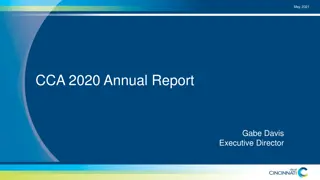Citizen Complaint Authority (CCA) Overview and Mission Statement
The Citizen Complaint Authority (CCA) is committed to investigating serious interventions by police officers and resolving citizen complaints in a fair and efficient manner. Their ultimate goals include addressing citizen concerns and improving perceptions of police service in Cincinnati. The organization's structure includes a Director, Investigators, and an Advisory Board. The complaint and investigation process involves multiple steps from intake to the final decision sent to the Chief of Police.
Download Presentation

Please find below an Image/Link to download the presentation.
The content on the website is provided AS IS for your information and personal use only. It may not be sold, licensed, or shared on other websites without obtaining consent from the author.If you encounter any issues during the download, it is possible that the publisher has removed the file from their server.
You are allowed to download the files provided on this website for personal or commercial use, subject to the condition that they are used lawfully. All files are the property of their respective owners.
The content on the website is provided AS IS for your information and personal use only. It may not be sold, licensed, or shared on other websites without obtaining consent from the author.
E N D
Presentation Transcript
March 18, 2021 Citizen Complaint Authority (CCA) Update Law & Public Safety Committee Gabe Davis Executive Director
2 Overview Mission Statement Organizational Structure Investigation Process Case Scenarios 2020 Significant Accomplishments Ongoing Challenges & Opportunities Questions
3 Mission Statement The Citizen Complaint Authority s (CCA) mission is to investigate serious interventions by police officers, including, but not limited to discharging of firearms, deaths in custody, and major uses of force, and to review and resolve all citizen complaints in a fair and efficient manner. At a minimum, CCA has jurisdiction over complaints alleging excessive use of force; improper pointing of firearms; improper stops; improper entries, searches and seizures; and discrimination, including racial profiling.
4 CCA Ultimate Goals Address citizens concerns, improve citizens perceptions of quality police service in the City of Cincinnati Improve the delivery of those services
5 Organizational Structure Director, Investigators and Administrative Professionals Advisory Board: Up to 7 citizens appointed by Mayor, approved by City Council Current Voting Board Members: Mark (Zeek) Childers, Chair George Pye, Vice Chair Tim Barr, Jr. Tracey Johnson Luz Elena Schemmel Phyllis Slusher Wanda Spivey
6 City Manager Paula Boggs Muething CCA Director Gabriel Davis CCA Board Senior Chief Administrative Specialist Michelle Bonner Investigator Dena Brown Investigator Jessalyn Goodman Administrative Specialist Heidi Woods Investigator Jonathan Batista Investigator Morgan Givens Investigator Ike Ekeke
7 COMPLAINT AND INVESTIGATION PROCESS
8 Complaint and Investigation Process Summary of Steps: Intake Complaint is filed Investigation Review, Analysis and Determination CCA Findings & Recommendations Board Review City Manager s Final Decision Final Decision Sent to Chief of Police
9 Investigations Collaborative Agreement/Article XXVIII, Section 3 Memorandum of Agreement, Section 6 (paragraphs 35-56)
10 What complaints does CCA investigate? $14.6 $14.4 Secondary Causes of Action Investigated by CCA Discourtesy or Unprofessional Attitude Lack of Proper Service Improper Procedure Harassment Abuse of Authority Complaints Investigated by CCA Discrimination/Racial Profiling Improper Entry, Search and Seizure Excessive Use of Force Improper Stop Improper Pointing of Firearm Discharge of Firearm Death in custody $11.4$11.1 $9.0 $8.5
11 CCA Investigations Utilize an investigative protocol: Review the allegations Gather, review and analyze evidence Interview all parties involved and witnesses Interpret all applicable laws, regulations, policies, procedures, decisions, standard practices and training Analyze information, using the preponderance of evidence burden of proof Provide final analysis, conclusion and disposition Recommend action (when necessary) City
12 CCA Investigations Administrative investigations Burden of proof = preponderance of evidence Does 51% of the evidence favor one side or the other? 90 days Investigation completed, unless extenuating circumstances
13 CCA Investigations CCA s findings will be one of the following (consistent with MOA): Unfounded - where the investigation determined no facts to support that the incident complained of actually occurred; Sustained - where the person's allegation is supported by sufficient evidence to determine that the incident occurred, and the actions of the officer were improper; Not Sustained - where there are insufficient facts to decide whether the alleged misconduct occurred; or Exonerated - where a preponderance of the evidence shows that the alleged conduct did occur but did not violate CPD policies, procedures, or training.
14 CASE SCENARIOS
15 Case Scenario Complaint # Complainant CCA Investigator 18185 Julia Jeffries Dena Brown CCA Findings Complainant Marcella Juergens Sergeant Nathan Asbury Entry (Residence) -NOT SUSTAINED Officers Marc Schildmeyer and Deon Mack, Sergeant Nathan Asbury Procedure (Consent to Search) SUSTAINED Officer Marc Schildmeyer Improper Search (Residence) - SUSTAINED Officers Deon Mack and Cian McGrath, Sergeant Nathan Asbury Improper Search (Residence) - NOT SUSTAINED Officers Cian McGrath, Deon Mack and Marc Schildmeyer Procedure (BWC Turned off Early) SUSTAINED
16 Case Scenario Complaint On September 14, 2018, Ms. Julia Jeffries alleged that Cincinnati Police Officers stopped her son in a vehicle and took him into custody at gunpoint . . . Further, Ms. Jeffries alleged that police officers improperly entered and searched the residence of her mother, Ms. Marcella Juergens.
17 Case Scenario Analysis Police obtained written consent for the officers to conduct a search . . . . However, CPD training provides that a consent search should be limited to only those places and things that the person expressly or impliedly authorized to be searched. . . . BWC footage showed that, prior to signing the form, Ms. Juergens indicated her belief that the officers only intended to search Mr. Jeffries s bedroom. When she attempted to clarify this point with the lead officer, that officer responded, Just his room, because he told us, and then [that officer] added that they would search his room and anything out in the open that may harm Ms. Juergens or the officers. Only then did Ms. Juergens sign the Consent to Search Form.
18 Case Scenario Analysis Rather than limit the search of the residence to Mr. Jeffries s bedroom and to anything out in the open as [the officer] stated, police proceeded to search the entire residence, going inside of drawers and cabinets. Several BWCs were turned off too early, and before the completion of the search.
19 Case Scenario Complaint # Complainant CCA Investigator 20048 Ladon Mitchell Jessalyn Goodman Officer Alyssa Twehues Improper Stop EXONERATED CCA Findings Officers Alyssa Twehues, Clinton Butler, and Corey Gould Improper Search EXONERATED Officers Alyssa Twehues, Clinton Butler, and Corey Gould Discrimination UNFOUNDED
20 Case Scenario Complaint On January 23, 2019, Mr. Mitchell was pulled over by Cincinnati Police Officers for traffic violations which included having dark window tint and a covered license plate. Mr. Mitchell believed it was a baseless traffic stop. A Canine Officer responded. Mr. Mitchell did not believe there was any basis to request a canine, and that the stop took too long. After the canine sniffed around Mr. Mitchell s vehicle, police allegedly illegally searched it. Mr. Mitchell believed that the officers utilized racial profiling as the basis for the traffic stop and subsequent search of his property.
21 Case Scenario Analysis BWC footage confirmed the vehicle appeared to have heavy dark window tint, which corroborated the officers reports. CPD policy permits citations for tint violations based on an officer s observations alone, without the need for a tint meter reading. CPD policy states that an officer does not need reasonable suspicion for a dog to sniff the outside of an automobile. The time awaiting the canine s arrival, as well as the perimeter sniff of the vehicle, was approximately 17 minutes total, which was reasonable under the law. CPD policy also states that if the narcotic canine alerts to contraband inside the vehicle, probable cause exists to search the entire vehicle and any containers within the passenger area without a search warrant.
22 Case Scenario Analysis While the existence of genuine and provable traffic infractions alone would not be enough to defeat an accusation of racial profiling, given that race could still be a factor in an officer s decision to stop an offending driver, in this case we have more than just a provable traffic infraction. The officers told CCA that information from neighborhood reports of drug dealing involving a vehicle matching the description of Mr. Mitchell s vehicle was the controlling factor that led to the stop. BWC chatter corroborated that assertion. The presence of heavy tints on the car minimized the opportunity for the officers to have observed that Mr. Mitchell was Black at the time of the stop. And no other aspects of the officers encounter with Mr. Mitchell (such as the search of his car) violated policy, procedure, or training.
23 2020 Accomplishments CCA commenced 75 new investigations based on citizen complaints. In addition, CCA referred 174 complaints to the Cincinnati Police Department (CPD) for investigation after screening and reviewing those complaints. CCA completed 44 investigations in and issued 305 findings associated with those cases. CCA responded to the scene of all officer-involved shootings (2 total). CCA responded to the scene of all cases involving deaths in police custody (2 total).
24 2020 Accomplishments CCA collaborated with CPD on CPD s periodic review of its use of force procedures, during which CCA issued multiple recommendations regarding CPD s proposed policy revisions. CCA issued 16 recommendations and 11 observations to the CPD. Those recommendations addressed police policy and training, including the following topics: investigatory stops, searches and frisks, Body Worn Camera (BWC) evidentiary access, BWC use policy, CPD s Use of Force Review Board, TASER deployment, defining harassment as an allegation, and more.
25 2020 Accomplishments CCA participated and led 19 community engagements and trainings, reaching approximately 270 people. CCA provided public with opportunity to participate in CCA s monthly Board Meetings virtually, for the first time in CCA s history. CCA published its 2019 Annual Report, which summarized CCA s activities and outcomes for the 2019 calendar year. CCA published its 2019 Patterns Report.
26 2020 Accomplishments CCA liaised with and provided guidance to public officials and representatives from other cities interested in creating an oversight agency or improving existing oversight functions. CCA hired, onboarded, and trained 3 new experienced and diverse Investigators, including a former NYPD detective fluent in Spanish, a former Cleveland prosecutor, and a counterintelligence investigator from the U.S. Intelligence Community.
27 Challenges Investigations backlog Limited capacity to fulfill non-investigatory duties
28 Opportunities: Community Engagement Current Resources: Engagement via Board Meetings Largely ad-hoc outreach and limited one-on-one engagements with CCA leadership Presentations in some communities and schools Additional Resources: Presentations in all 52 Cincinnati neighborhoods CCA Ambassador Program to organize outreach, strategically plan, and engage volunteers Community listening sessions Grassroots presence at community events Director s Officer Hours Increased complainant support Engagement via Board Meetings
29 Opportunities: Mediation Current Resources: Refer cases to CPD for Citizen Complaint Resolution Process (CCRP) Additional Resources: Collaborate with CPD to strengthen CCRP Adopt restorative justice, mediation- driven approach to some citizen complaints Utilize national best practices, including potential use of community or paid mediators Potential use of CCA personnel to staff or monitor mediations
30 Opportunities: Complaint Prevention via Pattern and Data Analysis Current Resources: Annual Patterns Report Annual Report Case recommendations Additional Resources: Bi-annual or quarterly reports on patterns and recommendations Deeper analysis of pattern circumstances and findings trends Recommendations informed by advanced policy research Collaborative problem-solving efforts driven by complaint data and law enforcement data
31 Questions? Citizen Complaint Authority 805 Central Avenue, Suite 222 Cincinnati, OH 45202 Telephone: 513.352.1600 Facsimile: 513.352.3158 Website: www.cincinnati-oh.gov/ccia/ Email: CCA@cincinnati-oh.gov twitter1 facebook1
